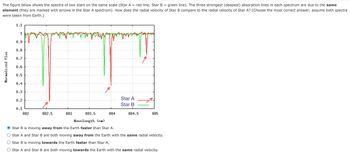Question

Transcribed Image Text:The figure below shows the spectra of two stars on the same scale (Star A = red line; Star B = green line). The three strongest (deepest) absorption lines in each spectrum are due to the same
element (they are marked with arrows in the Star A spectrum). How does the radial velocity of Star B compare to the radial velocity of Star A? (Choose the most correct answer; assume both spectra
were taken from Earth.)
Normalized flux
1.1
1
0.9
0.8
0.7
0.6
0.5
0.4
0.3
0.2
0.1
882
882.5
883
883.5
884
Star A
Star B
884.5
885
Wavelength (nm)
Star B is moving away from the Earth faster than Star A.
Star A and Star B are both moving away from the Earth with the same radial velocity.
Star B is moving towards the Earth faster than Star A.
Star A and Star B are both moving towards the Earth with the same radial velocity.
Expert Solution
This question has been solved!
Explore an expertly crafted, step-by-step solution for a thorough understanding of key concepts.
Step by stepSolved in 3 steps with 8 images

Knowledge Booster
Similar questions
- f a star has a luminosity of 4*10^26 Watts and a brightness of 1.4*10^3W/m2, how far away is it?arrow_forwardA certain star has a (B-V) color index of 0.61 and a B magnitude of 6.87. How many times brighter is this star when measured using a V filter than when using a B filter?arrow_forwardThe stars in a CCD image include stars in a cluster and stars in front of the cluster (i.e. starts that don't belong to it). One group has parallaxes clustered around of 3 milli-seconds of arc (or "3 mas"). The parallaxes of the other group range from 10 mas to 15 mas. Which group contains the stars in the cluster? Explain your answer.arrow_forward
- If Star A's temperature is 5000 K and Star B's wavelength of peak emission is 5/7 as long as that of Star A, what is the temperature of Star B (in K; don't write the units in the text box)?arrow_forward(Answer don't copy with hand written please)As a star runs out of hydrogen to fuel nuclear fusion in its core, changes within the star usually cause it to leave the main sequence, expanding and cooling as it does so. Would a star with a radius 12 times that of the Sun, but a surface temperature 0.5 times that of the Sun, be more, or less luminous than the Sun? Show and explain your reasoning. You may assume the surface area of a sphere is A = 4πr2.arrow_forward
arrow_back_ios
arrow_forward_ios